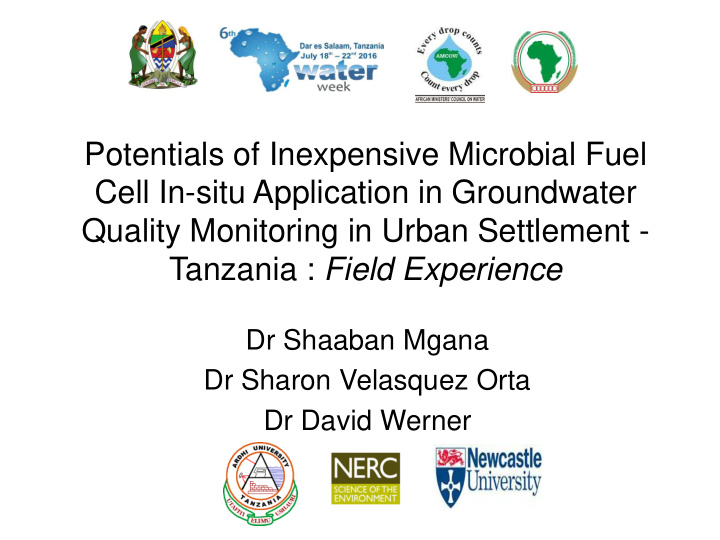



Potentials of Inexpensive Microbial Fuel Cell In-situ Application in Groundwater Quality Monitoring in Urban Settlement - Tanzania : Field Experience Dr Shaaban Mgana Dr Sharon Velasquez Orta Dr David Werner
Definition: Microbial Fuel Cell (MFC) MFC – Is a bio-electrochemical device that produces electrical energy through the action of specific microbes known as anodophiles. Since the production of electricity can be altered by either the microbial consumption of substrate or the inhibition of metabolic pathways by toxic compounds, MFCs can be applied as microbial biosensor for in-situ analysis and monitoring target chemicals (Sharon Velasquez-Orta, 2016).
Definition: Microbial Fuel Cell (MFC) (Continues) • MFC produces electric current proportional to quantity of biomass present in the pollutant • The amount of electric current produced is directly proportional to organic load contained in a sample measured in concentrations of COD or BOD Pit latrine Well Plume Organic pollution migration (COD or BOD
WORKING PRINCIPLE OF MFC CO 2 C 6 H 12 O 6 + 6 H 2 O 6 CO 2 + 24 H + + 24e - Electric Protons circuit 6 O 2 + 24H + + 24 e - 12 H 2 O Water
Mediators or direct contact Electrons Electrode (Anode) Electrical Circuit Electrons Electrode (Cathode)
Electrodes wiring in a shallow well leading to a real time monitoring facility- Picologger and computer Shallow Well + Wiring
PICO Logger Computer 50Ω 50Ω Electrode in well water Electrode in sediment Section B-B: MFC1 Section A -A: MFC2 Electrode Stainless steel mesh material: Anode size – 10 cm x 10 cm Electrode Sizes: Cathode size - 2 cm x 2 cm
Potential Difference (mV) Addition of contaminant (MFC3 – 312 mgCOD/L; MFC4 – 294 mgCOD/L) Time (Days) Potential Difference (mV) of the electrolyte increases after addition of contaminant – MFC3 & MF4 (Control Experiments)
MFC1 MFC2 Potential Difference (mV) Time (Hours) Figure 2: Performance of a Microbial Fuel Cell Biosensors installed in a household shallow well
Conclusion: These results show promising in-situ real time ground water monitoring needed for real time protection of public health particularly in urban settlements susceptible to groundwater pollution due to on-site pollution sources. However more field studies are needed to calibrate the performance of the biosensor together with provision of alarm to signal exceedance of predetermined contaminant levels Acknowledgement: The research work has been carried out jointly by University of Newcastle upon Tyne of The UK, School of Chemical Engineering and Advanced Materials in collaboration with School of Environmental Science and Technology of Ardhi University. Dr Sharon Velasquez Orta of Chemical Engineering and Advanced materials at the University of Newcastle upon Tyne is the Lead Collaborator. The co-investigators are Dr David Werner of Civil Engineering and Geosciences at the University of Newcastle upon Tyne; Dr Shaaban Mgana at Ardhi University (ARDHI) and project partner Mr Chacha Nyamboge at School of Environmental Science and Technology, Ardhi University. The Natural Environment Research Council of the UK ("Funding Body") has awarded grant for carrying out the titled research- Inexpensive monitoring of Groundwater pollution in Urban African Districts
Recommend
More recommend